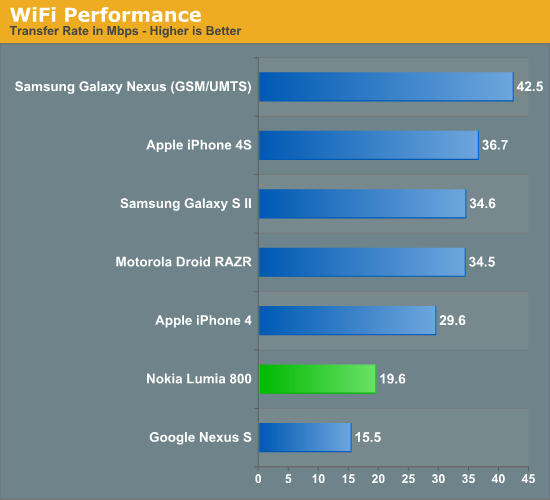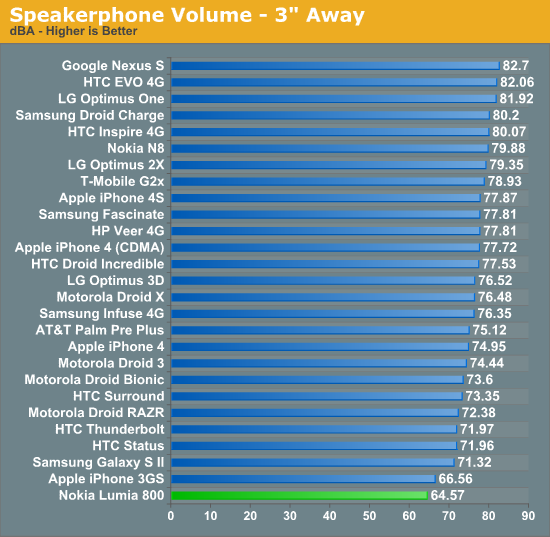Nokia Lumia 800 Review - Nokia's Brave New Foray into WP7
by Brian Klug on January 4, 2012 7:00 AM EST- Posted in
- Smartphones
- Nokia
- windows phone 7
- Mobile
- WP7
- Lumia
- Lumia 800
Cellular
Cellular on the Lumia 800 is supplied courtesy the MSM8255’s onboard baseband. Like all the Qualcomm S2 parts, this means GSM/EDGE/WCDMA with HSPA+. The Lumia 800 also takes a microSIM as noted earlier, and I tested on AT&T in my market. There are actually two Lumia 800 variants, each with different WCDMA bands - we were sampled the European variant which worked with AT&T’s PCS 1900 MHz WCDMA in my market. The Nokia Lumia 800 Specifications page is a bit misleading since it would have you believe that there’s only one variant with quad-band WCDMA when there are actually two different tri-band WCDMA devices.
| Nokia Lumia 800 - Network Support | |
| GSM/EDGE Support | 850 / 900 / 1800 / 1900 MHz |
| RM-801 (Europe) WCDMA Support | 900 / 1900 / 2100 MHz |
| RM-819 (USA) WCDMA Support | 850 / 1900 / 2100 MHz |
| Baseband Hardware | QCT MDM8255 w/QTR8200 |
| HSPA Speeds | HSDPA 14.4 (Cat.10) / HSUPA 5.76 (Cat.6) |
I couldn’t do my usual stats collection and histogram on the Lumia 800 since there’s no way to export that data from any of the speed test applications on Windows Phone. However, I did run some tests and see acceptable levels of throughput out of the device.
.jpg)
.jpg)
Some speedtests taken with BandWidth on WP7
WiFi
WiFi and Bluetooth 2.1 EDR on the Lumia 800 is supplied courtesy of a Broadcom BCM4329 combo chip which we’ve seen numerous times before in a number of different smartphones. Though newer devices are starting to ship BCM4330, I wager that WP7.5 includes drivers for just BCM4329 (which a huge majority of Windows Phones include) and BCM4325 (Venue Pro). On the Lumia 800, this means single spatial stream 802.11b/g/n connectivity only on the 2.4 GHz band.

Regardless, WiFi range on the Lumia 800 is totally par for the current generation of devices. In addition, WP7.5 continues to do a great job at deciding when to hand off and back onto WiFi when leaving the coverage radius of your house. It’s the small things like these that (to me at least) really demarcate the previous generation of smartphone OSes from the new breed. Unfortunately, in our throughput test which consists of loading a 100 MB PDF hosted locally on an 802.11n network, the Lumia 800 isn’t quite up to the speed of other BCM4329 devices. I’d wager this has more to do with the OS than anything else, though running network throughput applications on the Lumia 800 also gave a similar number to our normal PDF download test.
I should also note that WP7.5 also includes the ability to connect to WiFi APs that don’t broadcast their SSID. There’s a tab under Advanced in WiFi that now allows you to enter all that information and connect away, this wasn’t possible until Mango.
Speakerphone
In calls, the speakerphone on the Lumia 800 is honestly a bit too quiet, and our testing with a sound level data logger backs this up. Even at absolute maximum (where we test, of course) I found the sound level inadequate while using Nokia Drive or placing calls. It isn’t so much the position of the speaker at the bottom that’s a problem (in fact this is a good place to locate it), it’s just not loud enough.

Hopefully, this can be addressed with some software tweaking of the gains for speakerphone volume.
I also recorded some call quality test samples on the Lumia 800. The smartphone also does have the multiple microphone system for common mode noise rejection, though I'm not certain whose IP is being leveraged - perhaps Qualcomm's Fluence?
Noise rejection on the Lumia 800 is very good at all but the most extreme volume levels. Still, there are handsets that can completely reject the ambient noise that you hear at our maximum volume level. Unless you're in an absurdly loud environment, chances are the Lumia 800 will do a good job rejecting noise common between the two microphone system.
GPS
The Lumia 800 uses the GPS/GLONASS (GNSS) system onboard MSM8255 which we’ve seen numerous times before. Though WP7 doesn’t have API access to NMEA data so we can see SNR from individual satellites, the Lumia 800 does seem to get a GPS lock speedily enough even in some tough environments. In both the maps application and Nokia Drive I had no issues getting a GPS lock in under a 5 seconds keeping the lock for the duration of navigation.










120 Comments
View All Comments
465thGTG - Wednesday, January 4, 2012 - link
Sounds like you aren't thoroughly familiar with Windows Phone. As far as performance goes, my Titan consistently feels faster and more fluid than my Galaxy S II, which has ungodly specs. Benchmarks may paint one picture, but real world use paints a completely different one.Speaking of the Titan, I can't believe Brian didn't mention it at all. Its camera is a clear step above both the Focus S and Lumia 800.
doubledeej - Thursday, January 5, 2012 - link
What evidence do you have for WP7 needing dual core? My HTC HD7 runs circles around my coworker's Galaxy S II with a lower clock speed and half of the number of cores.WP7 renders graphics using the GPU so everything feels fast and fluid. Android doesn't even attempt to do that until 3.0 (which isn't available on phones). ICS adds it, but not many models are getting that yet.
AMOLED is beautiful. Fully saturated colors and infinite contrast ratio. I'd take an AMOLED at half of the rated brightness of an LCD any day. The AMOLED screens in production aren't too dim. But some of the LCDs can get too bright.
french toast - Thursday, January 5, 2012 - link
I agree AMOLEDS are awesome!, i havnt seen a modern one but i saw my mates HTC desire when that came out and it was cool, if they have improved since then then i want one!I havnt used WP7 so i cant comment on responsivness, but what i will say is that multi cores devices actually bring the power consumption DOWN, whilst making something that can be multithreaded eg web browsing even smoother, it also gives games developers power to make better games, the GPU on the old snapdragon is weak, so while the OS may run smooth thanks to miccrosofts supreme optimizations,you cant tell me you wouldnt want better more powerfull engine inside, that gives better battery life as well as better games would you?
Either way, WP7 whilst clearly very slick, is selling like ice creams in antartica, and i think this has to do with the pecieved out of date specs, like NFC duel core LTE etc, people want the lastest gadgets with the same stuff there friends have..
Microsoft MUST start delivering some up to date hardware.
LB-ID - Wednesday, January 4, 2012 - link
Brian, just FYI. Article's last page, paragraph three:"at least min my mind"
I believe that should be: "at least in my mind".
Thanks for the article and analysis!
Brian Klug - Wednesday, January 4, 2012 - link
Fixed!-Brian
Brian Klug - Wednesday, January 4, 2012 - link
Thanks for all the edits/corrections everyone, I've made a number of changes (all those listed here). :)-Brian
comomolo - Wednesday, January 4, 2012 - link
I understand Nokia doesn't want the N9 to succeed or their Windows Phone strategy is doomed. But this is an independent news site, isn't it? Where's the N9 in the comparison charts? Where's the N9 review? Comparing the Lumia with the phone it inherited the design from (the N9) is only logical. Hiding it from your readers is not very professional.Yes, Nokia decided to "kill" Meego (that's just a public statement; it's obviously their "plan B" and will be the basis for their upcoming "low end" Meltemi), but for a whole lot of people who couldn't care less about "ecosystems" (which is just a new euphemism for "lock-in"), its applications offer is pretty nice. In some areas, like telephony, is much better than anything else on the market, and because it's fairly open, lots of hacks and community apps and add-ons are being developed every day. Honestly, unless you lack any knowledge of technology (and then, why would you want a smartphone?) the N9 is currently offering much better value than the Lumia or any other Windows Phone 7 device.
Belard - Wednesday, January 4, 2012 - link
I'm looking at jumping from Android to WPx... as it is, I am running the free WP7 Launcher on my Android that makes using the phone so much easier than the default Android one.I see postings from WP7 owners wishing the titles would rotate with the phone (As we know, not even iOS and Android does this)...
But there is the cool thing, the WP7 Launcher for Android *DOES* rotate the tiles - which not only looks cool, its handy and allows you to read the titles. Of course the wide titles can't rotate, but this function would SO be worth it.
Voldenuit - Wednesday, January 4, 2012 - link
Thanks for the great review!Minor nitpick, though. The F number by convention is reported as a reciprocal when used with lower case 'f', and as a normal number when used with upper case 'F'. It's just one of those weird notation conventions in photography.
Example:
f/2.0 == F2.0 == an aperture with a diameter half the focal length of the lens.
Camera geek with N8 in hand ;).
Solidstate89 - Wednesday, January 4, 2012 - link
If they could get that rumored Lumia 900 on Sprint with the 4.3" screen, I would finally be able to switch to a pure software keyboard. The keyboard WP7 uses is utterly fantastic, from its sound to its autocorrect. It's juts great. However on the 3.6" screen on my Arrive, it's a bit cramped even when in landscape mode. However something as large as 4.3" is certainly enough to make me move.